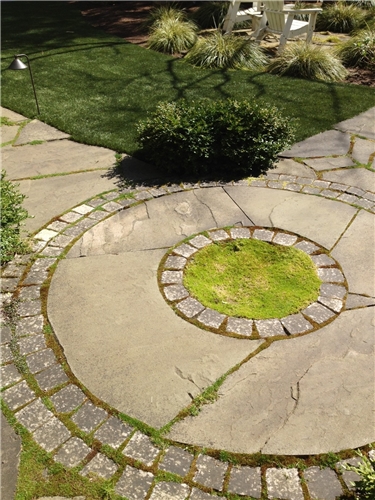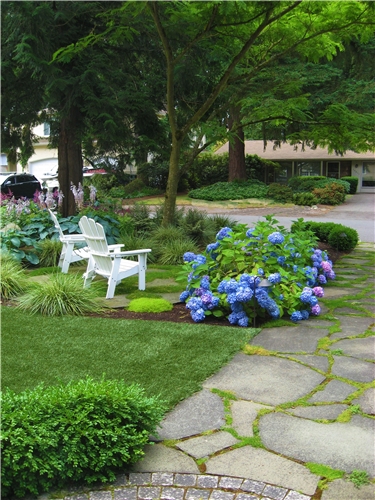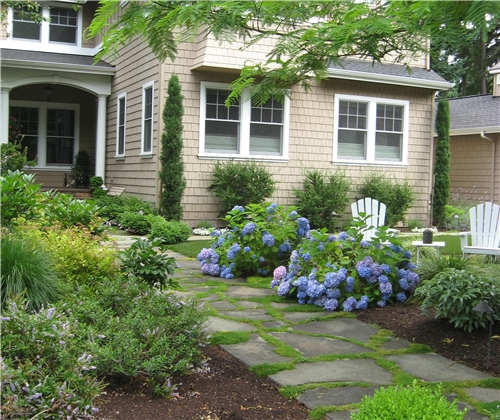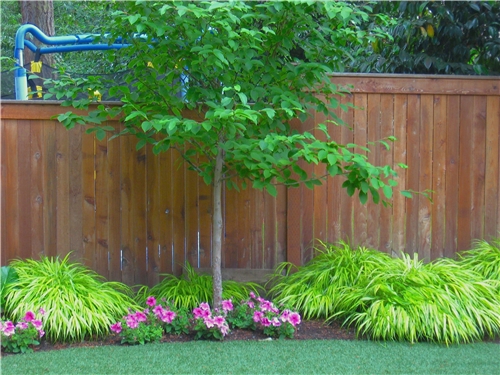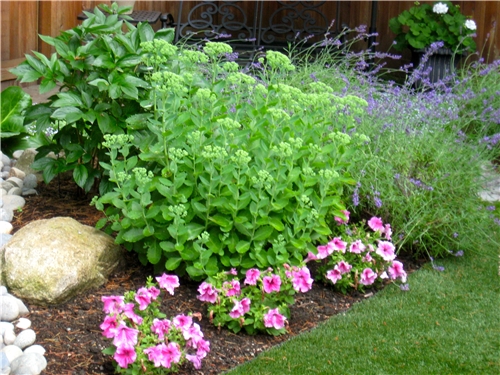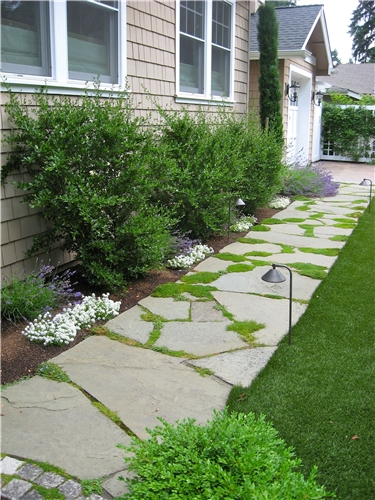Timeless Simplicity
Originally published in Landscaping Network
A Northwestern garden gets understated hardscapes and shade loving plants
By Maureen Gilmer, landscape designer, author and LandscapingNetwork.com columnist
Timeless design never goes out of style. When Robin Parsons' Seattle clients remodeled their older house, they sought to recreate the simple, traditional lines of a New England home in almond and white. Such a neutral, yet charming background was perfect for a sedate cool colored garden beneath the many old, mature conifers on site. These trees would become the most important influence on the planting design to come.
The owners were no ordinary clients, but a savvy real estate broker and his wife, daughter of a custom builder. They both understand how easily a home can look "dated" by its landscaping. So their approach is to keep it simple in terms of hardscape in order to keep their remodeled home looking timeless forever.
"They are both tuned in to the latest entertaining and decorating trends, and they want the home to be up to date and current." This made Robin's job a challenge because the clients knew exactly what they wanted. "They are keen on decorating for seasons indoors and out," so Robin allowed plenty of room for self expression. "The outdoor dining area was created as part of the home renovation." They needed a stronger front entry, a circulation plan and paved walks to link the home's outdoor spaces.
Robin chose low cost paving made of fragments of concrete in a flagstone pattern for the primary paving throughout the project. This left gaps in between for bright green Scotch moss that maintains itself during the rainy season, but enjoys underground irrigation if conditions become too dry in the summer. The pivotal point in the front entry was a circle of tumbled granite pavers to break up the long walk and provide integration to the side paths that link all parts of the site. This one dimensional amenity is low cost to build but high profile for visitors to pass over.
They came to Robin because she has a powerful plant sense coupled with visual skills from her former life as a graphic artist. Her well-honed sense of color, form and texture is manifest largely in the planting plan. "I am most influenced by the Van Sweden gardens where the plants are used in naturalistic drifts of color and texture. I'm really a plant person and it's important that anything I select for the landscape be well adapted to the microclimate. I also enjoy the challenge of working with sites like this where one can utilize the character of existing older plants."
This guided Robin in creating a more interesting front entry by exploiting a mimosa tree hidden behind a large fir. "I wanted its foliage and flowers to be visible out front, so we carefully pruned the fir to create 'windows' to view the mimosa. This resulted in the transparency I strive for in my projects where there's a much greater sense of depth." Such techniques are ideal for creating visual contrast in an often too dense canopy of trees. Robin was also diligent in assessing other existing plants and worked the new design around those to remain.
Pro Tip: When evergreens are pruned to open up a canopy or provide windows to deep inside a garden, be sure to consult a certified arborist first. This professional will help you know where to cut and how much without destroying the natural beauty of an evergreen.
Her greatest challenge was creating a garden in the backyard even more well shaded by old trees. "They wanted the two young children to have a play space so they wanted a lawn. Shade made it nearly impossible to grow grass there and maintaining it would be time and labor intensive. So we used new artificial turf that can fool even the most critical eye." Modern turf alternatives are not only perforated so rainfall percolates through, they're also great play spaces that don't generate mud in the rainy Northwestern climate.
Pro Tip: "Because it rains so much in the Northwest, we use cobble filled drainage swales to capture water and shunt it away from planting areas to keep them from over-saturation in the wet season. The cobbles are a strategy to slow water flow, because fast moving water is far better able to pick up soil particles and potentially erode away an unprotected flow line."
It was a challenge to create high diversity in the gardens when there's so much shade." Robin's plant palette for this project became a study in understory species, which are those plants found naturally beneath forests around the world. Many of her choices are locally native forest plants or newer varieties of natives that make better candidates for gardens. "I'm a big fan of sedges because they do so well in our wet climate. They're the best alternative to sun loving ornamental grasses because sedges thrive in both shade and sun. Carex morrowii 'Aureomarginata' is my favorite because its gold striping reflects and magnifies light.
The same is true for variegated Liriope muscari 'Silvery Sunproof' which also brings sunlight into the shade garden. "These give me yellow and gold year around, then I worked in a red leaf Heuchera hybrid, 'peach melba', which often holds its foliage into winter. Heucheras require a slightly elevated position to enhance drainage because they often rot out here when grown in heavy soils during wet weather.
Out front the beautiful Hydrangea macrophylla 'Nikko Blue' are a real attention getter when flowering. They blend into the locally native and exotic ferns which thrive in shade. These and the magenta flowered astilbe create a quiet, yet visually intriguing composition.
It's rare to find an accomplished designer with a strong sense of the local plant palette. Double this when the choices are limited to species for shade. The selection of a small company with a designer who really cares is often the best way to create a truly magnificent garden. With all the emphasis on the built environment, this project proves that where the climate is amenable, the best landscapes are defined by their plants.
Robin Parsons'Palette: Foliage Color for Shade Gardens
Astilbe arendii’ ‘amethyst’ Astilbe Carex morrowii 'Aureomarginata' Variegated Sedge Cortaderia 'Gold Band' Dwarf Pampas Grass Hakonechloa macra ‘aureola’ Golden Japanese Forest Grass Heuchera hybrids ‘peach flambe’ Coral Bells Helleborus ‘Hybrids’ Hellebore Hosta ‘sum and substance’ Hosta Liriope muscari 'Silvery Sunproof' Variegated Lily turf Pieris ‘Forest flame’ Japanese Andromeda Stewartia ‘pseudo camellia’ Japanese Stewartia Tree

